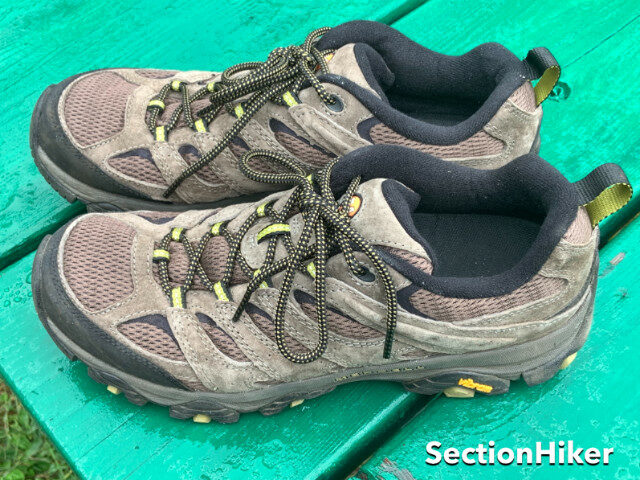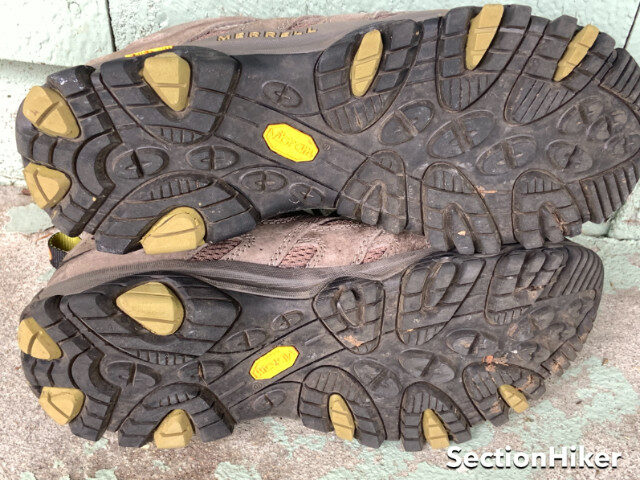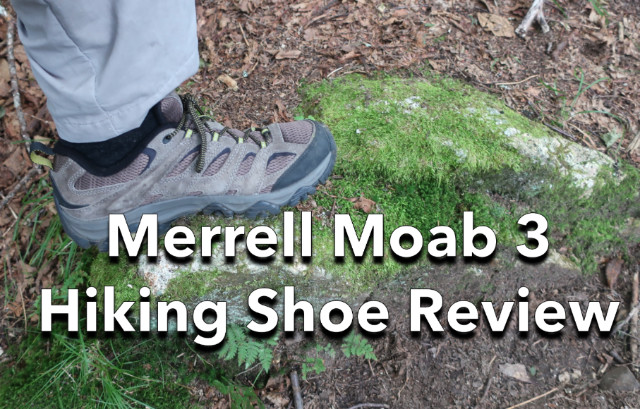The Merrell Moab is the most popular hiking shoe in the world with over 25 million shoes sold since it was first introduced 15 years ago. Now in its third generation, the Merrell Moab 3 (Merrell dropped the word ‘Ventilator’ in this new model), is very similar to its predecessor, the Moab 2 Ventilator, with a few changes including an improved factory insole, a more cushioned midsole, stickier Vibram soles, and more recycled content. If you’re looking for a low hiking shoe that’s very stable and supportive, has a wide toe box with good toe protection, and drains and dries quickly when it gets wet, the Moab 3 will satisfy your needs.
Specs at a Glance
- Upper: Pigskin leather/mesh upper
- Lining: Recycled mesh
- Midsole: Super Rebound Compound (ie. foam)
- Support: Molded nylon arch shank
- Outsole: Vibram TC5+
- Cushioning: Moderate
- Fit: Runs wide and slightly long
- Heel to Toe Drop: 11 mm
- Lug length: 5 mm
- Weight (pair): 2 lbs 1 oz (men’s size 9)
- Waterproof Version Available: Moab 3 Waterproof
- Wide Sizes Available: Yes (Merrell has the best selection)
- Women’s Models: Yes
Midsole Support and Cushioning
Low hiking shoes like the Moab 3 are a good alternative to hiking boots because they’re much lighter weight but still provide excellent midsole support. Most low hiking shoes also include a nylon or thermoplastic shank, which is a rigid strip of material in the midsole that helps support and protect the arch of your foot. The arch of your foot distributes pressure and impacts across your foot and helps align the ligaments, muscles, and bones in your legs and back. If your arch collapses, it leads to plantar fasciitis and acute heel pain, something experienced by many hikers and backpackers.

Unlike hiking shoes, most trail runners don’t have shanks and instead rely on foam cushioning in the midsole, which loses resiliency and shock absorption with use, something that a rigid midsole shank is immune to. The Moab 3 does include a lot of cushioning as well, but it’s mainly concentrated in the midsole, tongue, and heel cup, and much less so under the toe box. This gives you a lot of feedback about changing surface conditions with each step you take, providing the shoes with an excellent level of “trail feel”, which is a little surprising to find in an otherwise burly trail shoe.
Traction
The Moab 3 has a Vibram outsole with well-spaced lugs that provide good traction across a variety of terrain. The rubber outsole isn’t as sticky as most trail runner outsoles, but the outsole is flexible enough for scrambling on granite and hiking along dirt and gravel-topped trails

The outsole has a slight midsole arch so they can be worn with gaiters and the forefoot and ankle are slightly rockered to assist in forward motion. The lugs are widely spaced to provide traction in mud and are positioned at multiple angles to provide good braking on descents. They also extend slightly out along the perimeter of the midsole which helps with edging and scrambling in rocky terrain. I found the firm sole to provide a good bite when traversing boulder fields and wet river rocks, with just enough give to grip pointed and rounded wet surfaces without slippage. Based on previous experience, I expect these firm Vibram soles will wear well with extended use.
Stability
The Moab 3 is a super stable, almost blocky shoe, with a wide toe box and midsole that tapers when it reaches the well-padded and cushioned heel. While the outsole is moderately firm, the shoe has good torsional flexibility to adapt to rocks and other trail obstructions. In hiking with the Moab 3 with a 25-30 lb pack, I didn’t experience any ankle rolls or instability, even when scrambling up and down our rocky White Mountain Trails.
The heavily padded tongue helps lock your foot inside the shoe, even when you crank the laces, without any noticeable pressure on the top of the foot. It also prevents your foot from sliding down into the toe box and jamming your toes on steep descents.

In this latest version, Merrell has added a decent insole to the Moab 3, which is a new feature that makes them much more competitive with the Oboz Sawtooth X Low Hiker because Oboz includes such great insoles with all of their hiking boots and shoes. The insole provides more arch and heel support than the cheapo foam inserts that most manufacturers put in their hiking shoes or trail runners. It also includes extra padding under the metatarsal heads in the ball of the foot and in the heel.
Toe Box Width and Protection
As a hiker and backpacker, one of the first things I look at on a hiking shoe is the amount of toe protection at the front of the shoe and along the sides of the toe box. Shoes with beefy toe kicks protect toenails from nail trauma (which often manifests as thickened toenails) while bumpers along the sides of the toe box provide protection from side impacts.
The Moab 3, like many of Merrell’s hiking shoes, has a beefy toe kick that provides superior toe protection. It is an extension of the outsole, with front grooves that enhance the shoe’s grip and the sole’s flex when scrambling up inclined surfaces. Leather bumpers along the side of the toe box provide side protection while allowing the forefoot to flex freely.

The uppers along the side of the shoe are also made with pig suede leather and form a flexible but protective exoskeleton that protects the upper mesh from abrasion, while still allowing perspiration and moisture to escape. The heel is also well protected with leather and a rubber end cap, similar to the one protecting the toe box.
Ventilation and Drainage
The uppers on the Moab 3 are a porous mesh with protective leather strips for abrasion protection. The tongue and heel are heavily cushioned with a fleece-like fabric, while the forefoot has a synthetic mesh liner. Moisture and perspiration can escape through the mesh/mesh liner and around the ankle, keeping the inside of the shoe comfortable even in hot weather.

The Moab 3 dries very quickly when you get the upper wet in mud or puddles on the trail. If you completely submerge the shoe say during a stream crossing, it drains very quickly, although some water does soak into the heavier cushioning around the heel and in the tongue. However, the fleece fabric covering the cushioning wicks moisture away from your foot and sock so they quickly feel drier.
This wicking action helps migrate moisture to the exterior of the shoe where it can evaporate. The drying process can also be accelerated by putting the shoes in direct sunlight for a few hours. For what it’s worth, the lining and cushioning in the shoes is soft enough that it doesn’t cause blisters if you have to hike with the Moab 3s when they are still wet. But my preference is to avoid full submersion with these shoes if possible, even though they do drain and dry much faster than a full hiking boot.
Recommendation
The Merrell Moab 3 is a ventilated (non-waterproof) hiking shoe with pigskin leather reinforcements along the sides and heel for abrasion protection. It’s a very stable shoe with a nylon shank in the midsole that supports and protects your arch, which is important if you carry a loaded backpack (and not something you’ll find on a trail-running shoe). The Moab 3 also has a large toebox, in terms of width and height, with plenty of toe protection on the front and sides. Fitwise, the Moab 3 runs surprisingly wide out of the box in a regular size width, so I’d recommend avoiding them if you have narrow feet unless you’re comfortable “shimming” out the extra room with a thick hiking sock. Drainage is excellent with a surprisingly short dry time, making the Moab a good choice if you’re looking for stable and supportive hiking shoes that combine the best properties of trail runners and hiking boots in one shoe.
Disclosure: The author owns these shoes.
Compare 5 Prices
Last updated: 2022-09-07 02:43:07
SectionHiker is reader-supported. We independently research, test, and rate the best products. We only make money if you purchase a product through our affiliate links. Help us continue to test and write unsponsored and independent gear reviews, beginner FAQs, and free hiking guides.

